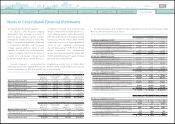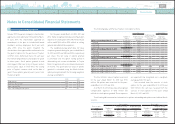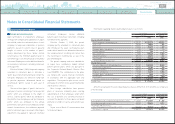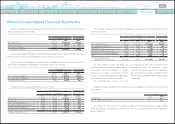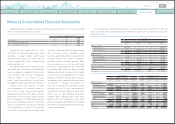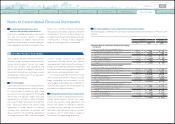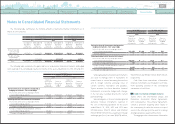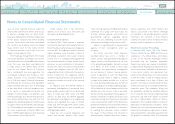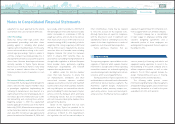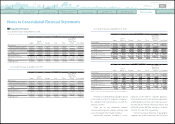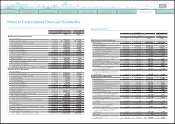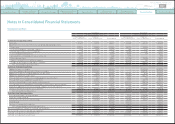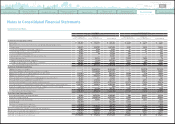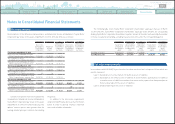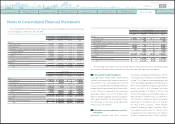Toyota 2012 Annual Report Download - page 111
Download and view the complete annual report
Please find page 111 of the 2012 Toyota annual report below. You can navigate through the pages in the report by either clicking on the pages listed below, or by using the keyword search tool below to find specific information within the annual report.
TOYOTA ANNUAL REPORT 2012
Toyota Global Vision Changes for Making
Ever-Better Cars President
ʼ
s Message Medium- to Long-Term
Growth Initiatives Special Feature Management and
Corporate Information Investor Information
Business and
Performance Review Financial Section
Notes to Consolidated Financial Statements
The minimum rental payments required under operating leases relating primarily to land, buildings
and equipment having initial or remaining non-cancelable lease terms in excess of one year at March
31, 2012 are as follows:
Years ending March 31, Yen in millions
U.S. dollars in millions
2013 ¥ 10,375 $ 126
2014 7,988 97
2015 6,510 79
2016 5,745 70
2017 5,094 62
Thereafter 20,653 252
Total minimum future rentals ¥ 56,365 $ 686
Other commitments and contingencies, concentrations and factors that may affect future operations:
23
Commitments outstanding at March 31, 2012 for
the purchase of property, plant and equipment
and other assets totaled ¥73,004 million
(
$888
million
)
.
Toyota enters into contracts with Toyota dealers
to guarantee customers
ʼ
payments of their
installment payables that arise from installment
contracts between customers and Toyota dealers,
as and when requested by Toyota dealers.
Guarantee periods are set to match maturity of
installment payments, and at March 31, 2012,
range from 1 month to 35 years; however, they
are generally shorter than the useful lives of
products sold. Toyota is required to execute its
guarantee primarily when customers are unable
Lexus vehicles related to floor mat entrapment
of accelerator pedals, and later expanded it to
include additional models. In January 2010, Toyota
announced a recall in North America for certain
models of Toyota vehicles related to sticking
and slow-to-return accelerator pedals. Also
in January 2010, Toyota recalled in Europe and
China certain models of Toyota vehicles related
to sticking accelerator pedals. In February 2010,
Toyota announced a worldwide recall related
to the software program that controls the
antilock braking system
“
ABS
”
in certain vehicle
models including the Prius. Set forth below is
a description of various claims, lawsuits and
government investigations involving Toyota in the
United States relating to these recalls and other
safety measures.
There are approximately 200 putative class
actions that have been filed since November 2009
alleging that certain Toyota, Lexus and Scion
vehicles contain defects that lead to unintended
acceleration. Many of the putative class actions
allege that malfunctions involving the floor mats
and accelerator pedals do not cover the full
scope of possible defects related to unintended
acceleration. Rather, they allege that Electronic
Throttle Control System-intelligent
“
ETCS-i
”
is the true cause and that Toyota has failed
to inform consumers despite its awareness
of the problem. In general, these cases seek
recovery for the alleged diminution in value
to make required payments.
The maximum potential amount of future
payments as of March 31, 2012 is ¥1,695,140
million
(
$20,625 million
)
. Liabilities for
guarantees totaling ¥13,981 million
(
$170 million
)
have been provided as of March 31, 2012. Under
these guarantee contracts, Toyota is entitled
to recover any amount paid by Toyota from the
customers whose original obligations Toyota has
guaranteed.
From time-to-time, Toyota issues vehicle recalls
and takes other safety measures including safety
campaigns relating to its vehicles. In November
2009, Toyota announced a safety campaign in
North America for certain models of Toyota and
of the vehicles, injunctive and other relief. In
April 2010, the approximately 190 federal cases
were consolidated for pretrial proceedings into
a single multi-district litigation in the United
States District Court for the Central District of
California. In addition, of more than 300 individual
product liability personal injury cases relating to
unintended acceleration pending against Toyota,
the federal cases have been consolidated into the
multi-district litigation. This consolidated federal
action has included document production,
depositions and various motions. The remaining
individual product liability personal injury cases
relating to unintended acceleration remain
pending in various state courts in the United
States. Additionally, there were approximately
10 putative class actions in various state courts,
including California. All cases except the
California case have been consolidated into the
multi-district litigation. The claims are similar
to the class actions in federal court. One of the
putative California class actions was filed by the
Orange County District Attorney and, among
other things, seeks statutory penalties alleging
that Toyota sold and marketed defective vehicles
and that consumers have been harmed as a
result of diminution in value of their vehicles.
Beginning in February 2010, Toyota has also
been sued in approximately 20 putative class
actions alleging defects in the antilock braking
systems in various hybrid vehicles that cause the
vehicles to fail to stop in a timely manner when
driving in certain road conditions. The plaintiffs
■
Commitments
■
Guarantees
■
Legal Proceedings
Product Recalls
Class Action and Consolidated Litigation
0820
Search NextPrev page 111
Contents


